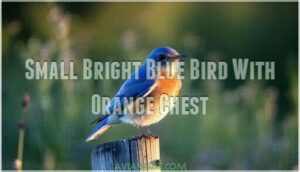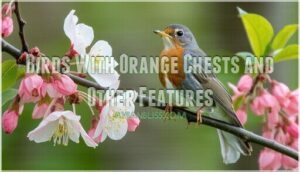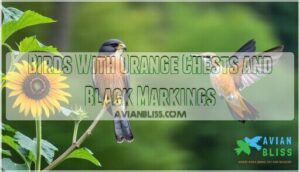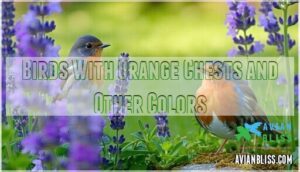This site is supported by our readers. We may earn a commission, at no cost to you, if you purchase through links.

American Robins sport that classic rusty-orange breast we all know, while Baltimore Orioles flash brilliant tangerine feathers.
Eastern Bluebirds surprise folks with their orange-rust bellies beneath blue backs.
Some real showstoppers include the Varied Thrush with its bold orange chest stripe and the Painted Bunting’s vibrant patches.
European species like the Robin Redbreast actually wear orange, not red despite their name.
These colorful birds range from tiny warblers to chunky thrushes, each using their bright plumage for different reasons – attracting mates, claiming territory, or simply being fabulous.
The orange coloring comes from carotenoid pigments in their diet.
Each species has unique field marks beyond just that orange chest.
Table Of Contents
- Key Takeaways
- Which Birds Have Orange Chests?
- Birds With Orange Chests in North America
- Bird Species With Rust-Colored Chests
- Small Bright Blue Bird With Orange Chest
- Birds With Orange Chests and Other Features
- Birds With Orange Chests and White Markings
- Birds With Orange Chests and Black Markings
- Birds With Orange Chests and Other Colors
- Conservation Status of Birds With Orange Chests
- Habitat and Behavior of Birds With Orange Chests
- Frequently Asked Questions (FAQs)
- Do bluebirds have orange chests?
- What birds have orange chests & bellies?
- Are orange chest birds migratory?
- Why do birds have orange chests?
- What bird has an orange head and chest?
- What do orange chest birds look like?
- What kind of bird has an orange chest?
- What kind of hawk has an orange chest?
- Do robins have orange chests?
- What bird has an orange chest?
- Conclusion
Key Takeaways
- You’ll find orange-chested birds everywhere – from backyard robins to forest orioles, these colorful species inhabit diverse environments across North America and beyond.
- Orange coloring comes from carotenoids in their diet – the same pigments that make carrots orange create these vibrant chest displays, with intensity varying based on what they eat.
- Males typically display brighter orange than females – this sexual dimorphism helps with mate selection and territory establishment during breeding season.
- Conservation threats are mounting for many species – habitat loss, climate change, and pollution impact these birds, with North America losing over 3 billion birds in fifty years.
Which Birds Have Orange Chests?
You’ll spot dozens of birds with orange chests across diverse habitats, from backyard feeders to forest canopies.
This vibrant chest color variation stems from carotenoid pigmentation—the same compounds that make carrots orange.
These pigments create stunning displays, especially during breeding season when males show off their brightest plumage.
Orange chest origins vary by species.
The familiar American robin sports its rusty-orange breast year-round, while Baltimore Orioles flash brilliant orange-and-black patterns.
You’ll find everything from tiny hummingbirds to hefty grosbeaks wearing this eye-catching color.
Bird identification becomes easier when you know what to look for.
Orange-chested species span multiple families—orioles, tanagers, thrushes, and warblers—each with distinct shapes and behaviors.
Their global distribution ranges from tropical rainforests to northern woodlands.
These colorful characters aren’t just pretty faces.
They’re ecological powerhouses, dispersing seeds, controlling insects, and pollinating flowers.
Bird colors like these orange breasts serve as nature’s billboards, advertising fitness to potential mates while helping us identify species in the field.
Birds With Orange Chests in North America
When you’re scanning North America for birds with orange chests, you’ll encounter remarkable species that make birdwatching unforgettable.
These vibrant creatures showcase fascinating plumage differences and regional variations.
- American Robin – Their rust-orange breasts brighten suburban lawns, with distinct migration routes bringing them north each spring.
- Eastern Bluebird – Combines brilliant blue wings with warm orange chests, displaying unique vocalizations and nesting habits in open woodlands.
Bird identification becomes easier once you know their signature features.
Bird Species With Rust-Colored Chests
Several bird species showcase beautiful rust coloration that catches your eye in the field.
The Eastern Towhee displays striking rufous-orange side patches against black upperparts, while Say’s Phoebe stands out with its distinctive rust-orange belly that separates it from other flycatchers.
You’ll spot the Spotted Towhee with rusty sides and streaked chest markings.
European Stonechat carries a dark rusty orange breast with mottled brown back, and the Rufous-tailed Robin shows rust-tinged chest and flanks.
These species demonstrate how rust coloration varies across different bird families and habitats.
Plumage change occurs seasonally in many species – some maintain their rust tones year-round while others shift colors during breeding seasons.
Diet influence affects coloration intensity, with carotenoid-rich foods enhancing orange hues.
Species identification becomes easier when you recognize these rust-colored patterns, especially distinguishing them from brighter orange breasted bird varieties like the American Robin.
Habitat variation also plays a role in coloration differences among populations.
Small Bright Blue Bird With Orange Chest
Hunting for that striking combination of brilliant blue and warm orange creates one of birdwatching’s most rewarding moments.
You’ll encounter several stunning species that showcase this vibrant color pairing, each with distinct Identifying Features that make field identification straightforward.
Eastern Bluebird males display brilliant blue upperparts with rusty-orange chest and belly, while females show grayer-blue wings with subtle orange wash.
Western Bluebird males feature deep blue head and wings with chestnut-orange shoulders and chest.
Dimorphism Details reveal females appear much duller in both species.
European Stonechat offers another blue-orange combination, though less common in North America.
Males show dark heads with white collar patches and orange-buff chest during breeding season.
- Picture this: An Eastern Bluebird perched on a weathered fence post, its electric-blue back catching morning sunlight while its orange breast glows like a tiny sunset.
Habitat Preference includes open woodlands, meadows, and farmland edges.
Diet Specifics focus on insects caught from perches.
Conservation Needs emphasize maintaining nest boxes and suitable habitat corridors.
Birds With Orange Chests and Other Features
You’ll find orange-chested birds display remarkable variety beyond their vibrant breast coloration, from distinctive wing patterns to unique bill shapes.
These additional features help you distinguish between similar species and understand their specialized ecological roles, which is crucial for distinguishing between them.
Distinguishing Features by Species
You’ll notice striking plumage variations between males and females across orange-chested species.
The American Redstart’s male flashes brilliant orange patches while females sport yellow-orange markings. Size differences help too—the robin bird measures larger than most warblers.
Listen for distinctive vocalizations: European robin songs contain up to 70 melodious phrases.
Juvenile markings often appear speckled before developing adult colors. Regional subspecies may show subtle color intensity variations.
Habitat and Range
You’ll find these birds calling home to wildly different places – from your backyard robin bird to remote mountain peaks.
European robin species prefer dense woodlands but adapt well to gardens, while orange-chested species show diverse Nesting Preferences and Migration Patterns across continents.
Supplementing their diet with quality wild birdseed can help them thrive.
- Habitat Loss threatens specialized species like Orange-breasted Sunbirds tied to specific ecosystems
- Climate Impacts shift bird distribution patterns, forcing Range Expansion into new territories
- Migration Patterns span thousands of miles as species follow seasonal food sources
- bird habitats vary from urban parks to pristine wilderness, shaping survival strategies
Conservation Challenges and Efforts
Orange-chhested birds face serious threats that’ll make your heart sink.
Habitat loss destroys 70% of their homes, while climate change shifts migration timing for nearly half of all species.
Pesticide impact reduces their bug buffet, causing population decline across North America.
Conservation strategies like nest box programs show promise—Eastern bluebirds rebounded 12% recently.
Supporting bird feeders conservation can provide vital support.
Bird conservation efforts need your support to combat these endangered species challenges, and addressing habitat loss and population decline is crucial.
Birds With Orange Chests and White Markings
Several species sport beautiful orange plumage accented with distinctive white markings that serve important purposes in identification and behavior.
These contrasting colors help with mate selection, territorial displays, and camouflage patterns across different environments.
When you’re out birding, look for these lovely orange-chested species with white markings:
- Red Knots display pale gray rumps and tails with mottled gray upperparts
- American Woodcocks show pale gray necks and mottled brown-gray upperparts
- Red-breasted Nuthatches feature short tails that are black and white
- Barn Swallows have long, forked tails with white patches
Here’s what makes identification tricky:
- Plumage variations between males and females often create confusion, especially during non-breeding seasons
- Regional variations in orange intensity can make the same species look dramatically different across geographic ranges
- Similar species like Cooper’s Hawks display rust colorations that birders frequently mistake for true orange chest colors
Female coloration tends to be more subdued, so pay attention to subtle bird identification features.
Recognizing birds with white markings can aid in distinguishing species.
These bird markings serve as essential distinguishing characteristics when comparing bird species and their chest colors.
Birds With Orange Chests and Black Markings
While white markings create subtle elegance, black markings against orange chests deliver dramatic contrast.
These plumage variations showcase nature’s artistry through bold patterns.
Cooper’s Hawks display rusty orange breasts with slate-gray backs and dark caps.
Allen’s Hummingbirds flash fire-orange throats against metallic green backs and black tails.
Juvenile markings often differ substantially from adult patterns, creating unusual sightings that challenge identification skills.
| Species | Orange Feature | Black Marking |
|---|---|---|
| Cooper’s Hawk | Rusty breast | Dark cap |
| Allen’s Hummingbird | Orange throat | Black tail |
| Bullock’s Oriole | Orange chest | Eye line |
| American Redstart | Orange patches | Black head |
Regional differences affect marking intensity, while some species show mimicry examples where similar patterns confuse observers.
These bird identification features help distinguish species during bird species comparison activities.
Birds With Orange Chests and Other Colors
Nature paints some spectacular combinations when Color Variations meet orange-breasted birds.
You’ll spot Barn Swallows flashing their steel-blue backs against vibrant orange chests, while Eastern and Western Bluebirds blend their signature blues with warm orange tones.
Plumage Patterns become even more striking in Varied Thrush, where mysterious black markings create dramatic contrast.
These bird plumage colors aren’t just for show.
Regional Differences influence how bright these hues appear, with Diet Influence playing a surprising role—berries rich in carotenoids literally paint these colorful birds from the inside out.
Hybridization Effects occasionally create unique color combinations you won’t find in any bird identification guide.
When you’re studying bird characteristics, notice how orange pairs with unexpected colors.
Some species sport subtle green highlights, while others flash white wing bars.
These bird chest colors help with mate selection and territory marking, making each sighting a mini masterclass in avian evolution and survival strategies.
Conservation Status of Birds With Orange Chests
Beautiful orange-chested birds face varying conservation status challenges across species. While some populations remain stable, others struggle against mounting pressures threatening their survival.
Habitat Loss remains the primary villain in this story. As forests disappear and wetlands drain, these colorful birds lose their homes. Climate Change shifts their world upside-down, altering migration patterns and food sources. Invasive Species compete for resources, while Pollution Impacts contaminate their environments.
The numbers tell a sobering tale: North America has lost over 3 billion birds in fifty years, with 229 species needing urgent Conservation Efforts. Forty-two species sit on the "Red Alert" list, teetering on extinction’s edge.
Here’s what’s driving these declines:
- Urban sprawl destroying nesting grounds faster than birds can adapt
- Pesticides reducing insect populations that form their primary food source
- Window strikes killing millions annually during migration periods
Bird conservation efforts show promise through dedicated programs. You can help by supporting local initiatives and creating bird-friendly spaces. Many of these birds, such as the Eastern Bluebird, benefit from the installation of nest box installations.
Habitat and Behavior of Birds With Orange Chests
You’ll find orange-chested birds in bird habitats ranging from coniferous forests to tropical coastlines.
Their Migration Patterns span thousands of miles seasonally, while Foraging Strategies vary dramatically between species.
Social Structures differ too—some flock together, others prefer solitary lives.
Nesting Habits adapt to each environment, from tree cavities to ground scrapes.
Vocalizations help establish territories and attract mates.
These bird behavior patterns reflect remarkable adaptability across diverse bird habitats in North America, where climate change increasingly challenges their survival strategies.
Frequently Asked Questions (FAQs)
Do bluebirds have orange chests?
Bluebirds don’t typically have orange chests.
Eastern and Western Bluebirds sport rusty-orange or chestnut breasts, while their backs remain blue.
You’ll spot this warm coloration contrasting beautifully with their signature blue plumage during breeding season.
What birds have orange chests & bellies?
You’ll spot American Robins with bright orange-red chests year-round. Baltimore Orioles, Bullock’s Orioles, and Eastern Bluebirds also display vibrant orange bellies during breeding season, making backyard birdwatching quite rewarding.
Are orange chest birds migratory?
Many orange-chested birds are migratory, but it depends on the species. You’ll find Baltimore orioles, scarlet tanagers, and blackburnian warblers migrate seasonally, while others like cardinals stay put year-round.
Why do birds have orange chests?
You’d think birds just woke up and chose violence with those flashy orange chests.
Actually, you’re seeing carotenoid pigments at work—these compounds from their diet create vibrant colors that signal health, attract mates, and establish territory dominance effectively, which is a result of their diet.
What bird has an orange head and chest?
You’ll spot the Baltimore Oriole most often – males flash bright orange heads and chests with black wings and backs.
American Robins also sport orange-red chests, though their heads stay grayish-brown.
What do orange chest birds look like?
Orange-chested birds display vibrant plumage ranging from soft peach to fiery rust colors.
You’ll notice males typically sport brighter oranges than females, with contrasting black wings, white markings, or colorful heads that make them stand out beautifully.
What kind of bird has an orange chest?
You’ll find numerous bird species sport vibrant orange chests—Baltimore orioles, American robins, Western tanagers, and Blackburnian warblers are common examples you might spot in your backyard adventures.
What kind of hawk has an orange chest?
Cooper’s Hawks can display orange-rust coloring on their chests, especially juveniles. You’ll also spot this warm orange breast plumage on Sharp-shinned Hawks during certain seasons and ages.
Do robins have orange chests?
Like morning sunlight painting the garden, you’ll spot American Robins sporting rusty-orange breasts that brighten any yard. These common thrushes wear their vibrant "robin’s-egg" colored chests proudly year-round.
What bird has an orange chest?
You’ll spot American Robins with their distinctive rusty-orange breasts year-round across North America. Baltimore Orioles, Scarlet Tanagers, and Eastern Bluebirds also display vibrant orange chest plumage during breeding season.
Conclusion
Picture yourself stepping into your garden at dawn, binoculars ready, as orange-chested songbirds emerge from the mist like living flames.
You’ve now got the tools to identify over 25 birds with orange chests, from common robins to rare warblers.
Remember, these vibrant colors come from carotenoids in their diet, making each sighting a tribute to nature’s chemistry.
Keep your field guide handy—you’ll spot these colorful treasures everywhere once you know what to look for.
- https://en.wikipedia.org/wiki/Orange-bellied_parrot
- https://www.ifaw.org/journal/most-endangered-birds
- https://parrotessentials.co.uk/blog/orange-bellied-parrot-australian-endangered-species
- https://www.ducks.org/newsroom/us-bird-populations-continue-alarming-decline-new-report-finds
- https://www.stateofthebirds.org/2025/tipping-point-species-2025/










